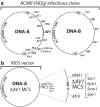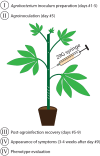Cassava geminivirus agroclones for virus-induced gene silencing in cassava leaves and roots
- PMID: 30154909
- PMCID: PMC6109987
- DOI: 10.1186/s13007-018-0340-5
Cassava geminivirus agroclones for virus-induced gene silencing in cassava leaves and roots
Abstract
Aim: We report the construction of a Virus-Induced Gene Silencing (VIGS) vector and an agroinoculation protocol for gene silencing in cassava (Manihot esculenta Crantz) leaves and roots. The African cassava mosaic virus isolate from Nigeria (ACMV-[NOg]), which was initially cloned in a binary vector for agroinoculation assays, was modified for application as VIGS vector. The functionality of the VIGS vector was validated in Nicotiana benthamiana and subsequently applied in wild-type and transgenic cassava plants expressing the uidA gene under the control of the CaMV 35S promoter in order to facilitate the visualization of gene silencing in root tissues. VIGS vectors were targeted to the Mg2+-chelatase gene in wild type plants and both the coding and promoter sequences of the 35S::uidA transgene in transgenic plants to induce silencing. We established an efficient agro-inoculation method with the hyper-virulent Agrobacterium tumefaciens strain AGL1, which allows high virus infection rates. The method can be used as a low-cost and rapid high-throughput evaluation of gene function in cassava leaves, fibrous roots and storage roots.
Background: VIGS is a powerful tool to trigger transient sequence-specific gene silencing in planta. Gene silencing in different organs of cassava plants, including leaves, fibrous and storage roots, is useful for the analysis of gene function.
Results: We developed an African cassava mosaic virus-based VIGS vector as well as a rapid and efficient agro-inoculation protocol to inoculate cassava plants. The VIGS vector was validated by targeting endogenous genes from Nicotiana benthamiana and cassava as well as the uidA marker gene in transgenic cassava for visualization of gene silencing in cassava leaves and roots.
Conclusions: The African cassava mosaic virus-based VIGS vector allows efficient and cost-effective inoculation of cassava for high-throughput analysis of gene function in cassava leaves and roots.
Keywords: ACMV; Agrobacterium tumefaciens; Agroinoculation; Cassava; Geminivirus; Gene silencing; VIGS.
Figures






Similar articles
-
A rapid virus-induced gene silencing (VIGS) method for assessing resistance and susceptibility to cassava mosaic disease.Virol J. 2017 Mar 7;14(1):47. doi: 10.1186/s12985-017-0716-6. Virol J. 2017. PMID: 28270156 Free PMC article.
-
A geminivirus-induced gene silencing system for gene function validation in cassava.Plant Mol Biol. 2004 Nov;56(4):613-24. doi: 10.1007/s11103-004-0161-y. Plant Mol Biol. 2004. PMID: 15630624
-
Virus-Induced Gene Silencing (VIGS) in Cassava Using Geminivirus Agroclones.Methods Mol Biol. 2020;2172:51-64. doi: 10.1007/978-1-0716-0751-0_5. Methods Mol Biol. 2020. PMID: 32557361
-
Virus-induced gene silencing is a versatile tool for unraveling the functional relevance of multiple abiotic-stress-responsive genes in crop plants.Front Plant Sci. 2014 Jul 8;5:323. doi: 10.3389/fpls.2014.00323. eCollection 2014. Front Plant Sci. 2014. PMID: 25071806 Free PMC article. Review.
-
A Methodological Advance of Tobacco Rattle Virus-Induced Gene Silencing for Functional Genomics in Plants.Front Plant Sci. 2021 Jun 4;12:671091. doi: 10.3389/fpls.2021.671091. eCollection 2021. Front Plant Sci. 2021. PMID: 34149770 Free PMC article. Review.
Cited by
-
Plant biomacromolecule delivery methods in the 21st century.Front Genome Ed. 2022 Oct 14;4:1011934. doi: 10.3389/fgeed.2022.1011934. eCollection 2022. Front Genome Ed. 2022. PMID: 36311974 Free PMC article. Review.
-
Linking CRISPR-Cas9 interference in cassava to the evolution of editing-resistant geminiviruses.Genome Biol. 2019 Apr 25;20(1):80. doi: 10.1186/s13059-019-1678-3. Genome Biol. 2019. PMID: 31018865 Free PMC article.
-
Genetic Transformation of Recalcitrant Cassava by Embryo Selection and Increased Hormone Levels.Methods Protoc. 2018 Nov 13;1(4):42. doi: 10.3390/mps1040042. Methods Protoc. 2018. PMID: 31164582 Free PMC article.
-
The importance of thiamine (vitamin B1) in plant health: From crop yield to biofortification.J Biol Chem. 2020 Aug 21;295(34):12002-12013. doi: 10.1074/jbc.REV120.010918. Epub 2020 Jun 17. J Biol Chem. 2020. PMID: 32554808 Free PMC article. Review.
-
Development of cassava common mosaic virus-based vector for protein expression and gene editing in cassava.Plant Methods. 2023 Aug 3;19(1):78. doi: 10.1186/s13007-023-01055-5. Plant Methods. 2023. PMID: 37537660 Free PMC article.
References
LinkOut - more resources
Full Text Sources
Other Literature Sources

